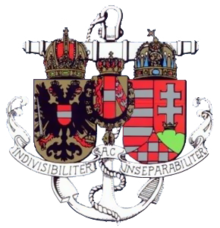
Back البحرية النمساوية المجرية Arabic Ваенна-марскія сілы Аўстра-Венгрыі Byelorussian Kaiserliche und Königliche Kriegsmarine Catalan Rakousko-uherské námořnictvo Czech Østrig-Ungarns marine Danish Österreichische Marine German Αυτοκρατορικό και Βασιλικό Πολεμικό Ναυτικό (Αυστροουγγαρία) Greek Armada austrohúngara Spanish Itävalta-Unkarin laivasto Finnish Marine austro-hongroise French
| Austro-Hungarian Navy | |
|---|---|
| Kaiserliche und königliche Kriegsmarine (German) Császári és Királyi Haditengerészet (Hungarian) | |
 Coat of arms of the Austro-Hungarian Navy | |
| Active | 1786–1867 (as the Austrian Navy) 1867–1918 (as the Austro-Hungarian Navy) |
| Country | |
| Type | Navy |
| Role | Defence of Austria-Hungary's naval interests, its merchant marine, and its coastline |
| Size | 1914: 20,000 personnel 4 dreadnoughts 9 pre-dreadnoughts 3 coastal defense ships 3 armored cruisers 2 torpedo cruisers 5 protected cruisers 2 scout cruisers 18 destroyers 25 high seas torpedo craft 29 coastal torpedo craft 6 submarines |
| Part of | Austro-Hungarian Armed Forces |
| Garrison/HQ | The Naval Section of the War Ministry |
| Nickname(s) | "Trieste Navy" (18th century)[1] |
| Motto(s) | Indivisibiliter ac Inseparabiliter (Latin: Indivisibly and Inseparably) |
| Engagements | |
| Commanders | |
| Holy Roman Emperor (1786–1804) | Joseph II (1786–1790) Leopold II (1790–1792) Francis II (1792–1804) |
| Emperor of Austria (1804–1867) | Francis I (1804–1835) Ferdinand I (1835–1848) Franz Joseph I (1848–1867) |
| Emperor of Austria and King of Hungary (1867–1918) | Franz Joseph I (1867–1916) Karl I (1916–1918) |
| Commander-in-Chief of the Navy (German: Oberkommandant der Marine) | Hans Birch Dahlerup (February 1849–August 1851) Franz Graf Wimpffen (August 1851–September 1854) Archduke Ferdinand Maximilian of Austria (September 1854–1861) Ludwig von Fautz (1861–March 1865) Wilhelm von Tegetthoff (March 1868–April 1871) Friedrich von Pöck (April 1871–November 1883) Maximilian Daublebsky von Sterneck (November 1883–December 1897) Hermann von Spaun (December 1897–October 1904) Rudolf Montecuccoli (October 1904–February 1913) Anton Haus (February 1913–February 1917) Maximilian Njegovan (April 1917–February 1918) |
| Commander-in-Chief of the Fleet (German: Flottenkommandant) | Anton Haus (July 1914–February 1917) Maximilian Njegovan (February 1917–February 1918) Miklós Horthy (February 1918–November 1918) |
| Chief of the Naval Section of the War Ministry (German: Chef der Marinesektion) | Ludwig von Fautz (March 1865–April 1868) Wilhelm von Tegetthoff (March 1868–April 1871) Friedrich von Pöck (October 1872–November 1883) Maximilian Daublebsky von Sterneck (November 1883–December 1897) Hermann von Spaun (December 1897–October 1904) Rudolf Montecuccoli (October 1904–February 1913) Anton Haus (February 1913–February 1917) Karl Kailer von Kaltenfels (February 1917–April 1917) Maximilian Njegovan (April 1917–February 1918) Franz von Holub (February 1918–November 1918) |
| Insignia | |
| Naval ensign: 1786–1915 |  |

The Austro-Hungarian Navy or Imperial and Royal War Navy (German: kaiserliche und königliche Kriegsmarine, in short k.u.k. Kriegsmarine, Hungarian: Császári és Királyi Haditengerészet) was the naval force of Austria-Hungary. Ships of the Austro-Hungarian Navy were designated SMS, for Seiner Majestät Schiff (His Majesty's Ship). The k.u.k. Kriegsmarine came into being after the formation of Austria-Hungary in 1867, and ceased to exist in 1918 upon the Empire's defeat and subsequent collapse at the end of World War I.
Before 1867, the Imperial Austrian Navy or simply the Austrian Navy, saw action in the French Revolutionary Wars, the Napoleonic Wars, the Austrian expedition against Morocco (1829), the Second Egyptian–Ottoman War, the First and Second Wars of Italian Independence, the Second Schleswig War, and the Third War of Italian Independence. Following Austria's defeat by Prussia and Italy during the Seven Weeks' War, the Austrian Empire reformed itself into the dual monarchy of Austria-Hungary, and the navy also became the Austro-Hungarian Navy. Largely neglected by the Empire in its early years, the k.u.k. Kriegsmarine expanded along with Austro-Hungarian industrialization into one of the largest navies in the Adriatic and Mediterranean Seas. By 1914, the k.u.k. Kriegsmarine had a peacetime strength of 20,000 personnel, seeing action in the Boxer Rebellion and other conflicts before World War I.
During most of World War I, the Allied Powers maintained the Otranto Barrage to bottle up the k.u.k. Kriegsmarine in the Adriatic Sea. Largely tasked with defending the Empire's 1,130 nautical miles (2,090 km; 1,300 mi) of coastline and 2,172.4 nautical miles (4,023.3 km; 2,500.0 mi) of island seaboard, the Navy chose to rely on its U-boats to attack Allied shipping rather than risk the destruction of its battleships, cruisers and other surface vessels. In June 1918, it attempted to break the Otranto Barrage with a large naval fleet, but the attack was called off after the battleship Szent István was sunk by an Italian torpedo boat on 10 June.
Five months later, with the Austro-Hungarian Empire facing collapse and defeat in the war, the Empire decided to transfer most of its navy to the newly declared State of Slovenes, Croats and Serbs on 31 October, effectively bringing the k.u.k. Kriegsmarine to an end. Three days later, the Empire's military authorities signed the Armistice of Villa Giusti, pulling the rapidly disintegrating empire out of the war. With the signing of the Treaty of Saint-Germain-en-Laye and the Treaty of Trianon, Austria and Hungary became landlocked, and the Empire's most important ports of Trieste, Pola, Fiume and Ragusa became part of Italy and Yugoslavia. The k.u.k. Kriegsmarine's main ships were turned over to the Allies, who scrapped most of them in the 1920s during the era of naval disarmament.
- ^ Sokol 1968, pp. 7, 9.
© MMXXIII Rich X Search. We shall prevail. All rights reserved. Rich X Search